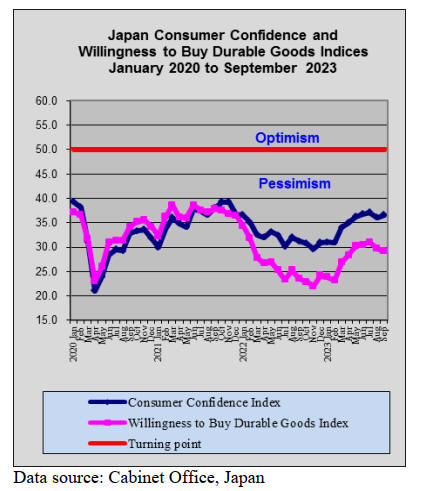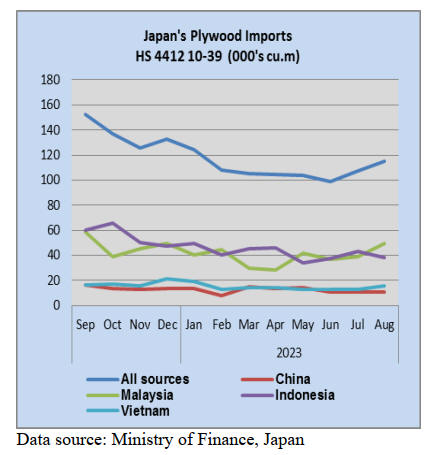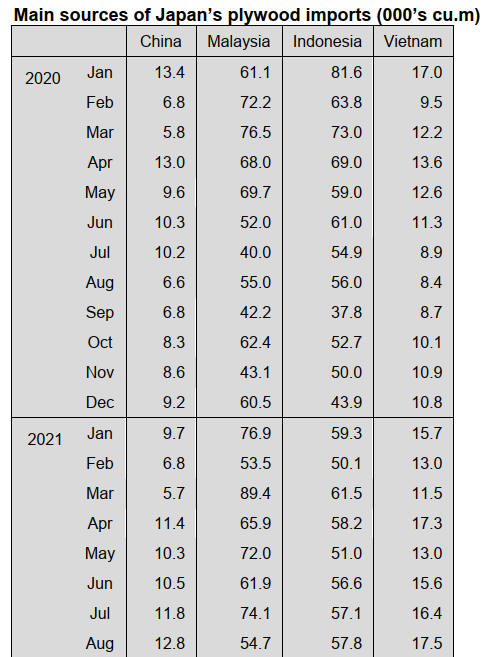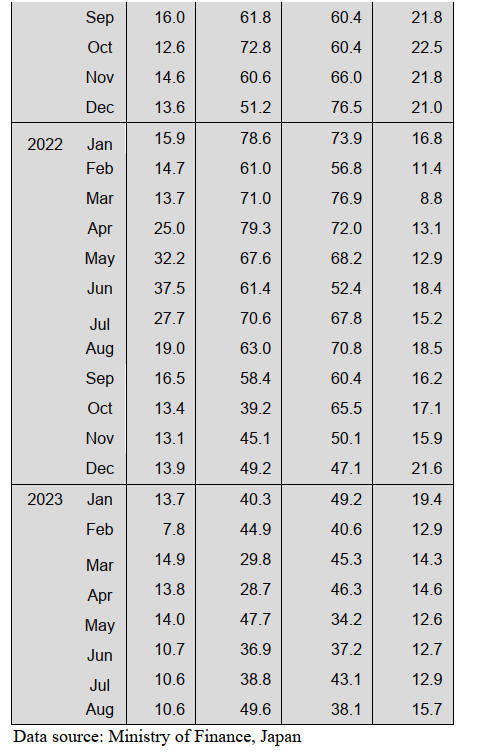Japan
Wood Products Prices
Dollar Exchange Rates of 10th
Oct
2023
Japan Yen 149.80
Reports From Japan
Growth forecast
raised
IMF's World Economic Outlook report says growth in the
Japanese economy is forecast at 2% for 2023 up from its
1.4% prediction in July citing "a surge in inbound tourism"
as one of the major factors. However, the IMF left its
forecast growth for the world's third-largest economy in
2024 unchanged at 1%.
As more foreign travelers choose Japan as a holiday
destination, drawn by the yen's recent weakness the
revision to the growth forecast is also attributed to pent-up
domestic demand, a pickup in car exports and the impact
of the ultra-loose monetary policy. After suffering supply
chain disruptions during the COVID-19 pandemic, Japan's
car makers and other export oriented manufacturers have
been recovering.
See:
https://www.imf.org/en/Publications/WEO
Small companies yet to experience a recovery
According to the joint survey by the Finance Ministry and
the Cabinet Office business sentiment among major
Japanese companies improved in the July-September
quarter driven by a recovery in car makers and other
manufacturers.
The business sentiment index for companies with a capital
of yen 1 billion or more rose to plus 5.8 from plus 2.7 in
the previous quarter. The index represents the percentage
of companies seeing their business conditions improve
from the previous quarter minus that of firms feeling the
opposite. A government spokesperson said “the outcome
reflects a continued moderate recovery in the economy.”
The index for large manufacturers rose to plus 5.4 from
minus 0.4, the first positive figure in four quarters as an
easing of semiconductor shortages lifted sentiment in the
auto industry. For large non-manufacturers the index rose
to plus 6.0 from plus 4.1, led by services and real estate
firms. The sentiment index stood at plus 6.1 for mid-size
companies but at minus 5.5 for small companies.
See:https://japannews.yomiuri.co.jp/business/economy/20230914-136382/
Further fall in household spending
August household spending in Japan dropped 2.5% from a
year earlier, declining for the sixth consecutive month as
rising prices forced a cut-back on food, education-related
outlays and non-essential household items such as
furniture. The rate of decline was smaller than the 5% in
July. Households of two or more people spent an average
of yen 293,161/month according to the Ministry of
Internal Affairs and Communications.
Food expenditure, accounting for around one-third of
household spending, fell 2.5% and outlays for education
dropped 14%. In contrast, spending on travel jumped 3%
as more people took a summer vacation following the
removal of coronavirus restrictions.
The continued weakness in spending came as real wages
dropped 2.5% in August for the 17th consecutive month of
decline as the impact of rising prices outweighed that of
salary increases. The data is a key indicator of private
consumption which accounts for more than half of the
country's gross domestic product.
See:
https://japantoday.com/category/business/update1-japan-household-spending-falls-2.5-in-august-on-rising-prices

Home loans now more expensive
In October four major Japanese banks have announced
they have raised their fixed housing loan rates for the third
consecutive month.
MUFG Bank will raise its 10-year rate for most preferred
customers to 0.94% while the rate will rise to 1.14% at
Sumitomo Mitsui Banking and to 1.45% at Mizuho Bank
and to 1.65% at Resona Bank. On the other hand,
Sumitomo Mitsui Trust Bank lowered its most preferred
rate to 1.26% after revising its interest rate system.
See:
https://www.japantimes.co.jp/business/2023/09/30/housing-loans-rate-rise/

According to the Dallas Morning News, one of North
Texas’ most prolific apartment developers is being
acquired by a Japanese forestry and construction
company. A subsidiary of Tokyo-based Sumitomo
Forestry has bought Irving-based JPI which is building
more than 4,000 rental units in Dallas-Fort worth this year.
Significantly, the new acquisition will see a greater focus
on mid-rise construction and the use of mass timber as part
of a global plan to substantially grow its “build to rent”
portfolio of apartment assets. Sumitomo Forestry is now
looking to utilise “2 x 4” mass timber construction to build
net-zero dwellings.
See:
https://therealdeal.com/texas/dallas/2023/10/03/sumitomo-forestry-acquires-irving-based-jpi/
Fighting deflation and taming inflation
With the yen close to its weakest level in decades, food
inflation hitting 9% and households suffering from the
rising cost of living, pressure is mounting on the Bank of
Japan (BoJ) to break loose from its ultra-loose monetary
policy.
Over the past few months, the BoJ has been faced the
impossible task of fighting deflation and taming inflation
simultaneously.
See:
https://asia.nikkei.com/Spotlight/The-Big-Story/Japan-s-yen-dilemma-in-charts-BOJ-juggles-deflation-and-inflation?utm_campaign=IC_asia_daily_free&utm_medium=email&utm_source=NA_newsletter&utm_content=article_link

Import update
Assembled wooden flooring imports
After three consecutive months of increases the value of
assembled wooden flooring import in August tilted lower
bringing the monthly average value of imports back to
levels seen in previous quarters. Year on year, August
2023 imports dropped over 30% and compared to the
value of July imports there was an over 20% drop in
August.
Of the various categories of assembled flooring imports in
August, HS441875 was the largest accounting for 67% of
the total value of assembled flooring imports followed by
HS441879. The main shippers of HS441875 in August
were China 44%, Austria 17% and Malaysia 13%. There
were no arrivals from Indonesia in August but shipments
from Thailand accounted for around 5% of the value of all
HS441875 imports.

Plywood imports
The volume of plywood imports in August, at 115,000
cu.m ,snapped the downward trend that became evident in
the first half of this year. But, compared to August 2022
imports in August 2023 fell by over 30%. Compared to the
volume imported in July there was a 23% rise.
Year on year the volume of plywood imports from the
main shippers Indonesia, Malaysia, Vietnam and China all
declined with sharper declines being observed for
Indonesia and Malaysia.
The Japan Lumber Report says “the movement of
imported plywood is not good and there is low demand”.
The price of concrete formboard from SE Asia was raised
by around US$20, C&F per cu.m in July. Production costs
are rising for plywood manufacturers and exporters are
seeking higher prices but with weak domestic demand and
the weak yen Japanese importers have to resist demands
for higher FOB prices. (See page 18)

 
Trade news from the Japan Lumber Reports (JLR)
The Japan Lumber Reports (JLR), a subscription trade
journal published every two weeks in English, is
generously allowing the ITTO Tropical Timber Market
Report to reproduce news on the Japanese market
precisely as it appears in the JLR.
For the JLR report please see:
https://jfpj.jp/japan_lumber_reports/
Orders for house builders
New orders for some house builders in August, 2023 are
10 % higher than August, 2022. However, demand of
houses is not recovered. Some house builders have good
sales for high value-added houses and the results of
August, 2022 were very dull.
The building costs were soaring in summer 2022 and
many house builders raised the selling price of a house.
Many house builders struggled with the sales in,
especially, July to September, 2022.
Moreover, demand of houses was different in cities,
suburbs and other areas. It is hard to say that orders for
house builders are good in this autumn. Since the
restrictions of activities due to COVID-19 have been eased
and it is easier to do business or attract customers than
before.
However, customers feel anxious to the economic in
the
future and the rising interest rates. They are cautious to
purchase houses.
Daiken to acquire WTK Reforestation
Daiken Sarawak Sdn. Bhd. in Malaysia, a subsidiary of
Daiken Corporation in Osaka Prefecture, concluded a
share transfer agreement with WTK Reforestation Sdn.
Bhd. in Sarawak, Malaysia on 11th, September and will
obtain all issued shares.
Daiken Sarawak will buy all shares from WTK
Reforestation’s parent company within this year. Daiken
aims to produce MDF made of trees from reforestation.
Daiken has four overseas MDF production bases and
produces about 550,000 cbms annually. About 50 % of
woody fiber materials is trees from Daiken’s reforestation
or other companies’ reforestations and the rest of woody
fiver materials is South Sea remnants.
Daiken Sarawak will reduce using South Sea lumber
gradually by using WTK Reforestation’s trees by 2025.
Also, the company plans to use own trees from own
reforestation for 60 – 70 % more in this year.
WTK Reforestation was established in 2000 and has about
5,400 hectares of reforestation. There are falcata trees and
acacia trees at the reforestation.
Fire resistant plywood
Sumitomo Forestry Co., Ltd. and Shin-Etsu Chemical Co.,
Ltd. developed fire resistant plywood. They started to sell
the fire resistant plywood on 1st, September.
Sumitomo Forestry received the certification on the fire
resistant plywood, which is 24 mm thickness and is used
to cover posts or beams, from the Ministry of Land,
Infrastructure, Transport and Tourism in March, 2023. The
company aims to receive the certification from the
Ministry of Land, Infrastructure, Transport and Tourism
for the fire resistant floors or walls for medium scale
buildings in the future.
The fire resistant plywood is 24 mm thickness, 910 mm
width and 1,820 mm length. The flame-retardant shaped
into tables is used on the both faces of domestic plywood.
Special machines are not needed for the fire resistant
plywood to process. Also, a process of drying the flame-
retardant is not needed. It is able to deliver the fire
resistant plywood in a short time and it will be the cost
reduction.
Demand and supply of domestic softwood plywood
According to the Ministry of Agriculture, Forestry and
Fisheries, inventory of domestic structural plywood in
August, 2023 is 132,000 cbms, 44.6 % more than August,
2022. This volume has remained flat from last month.
Inventory of domestic structural plywood soared in
August, 2022 and the inventory in July, 2023 was 66 %
higher than July, 2022 so it could say that the increase rate
in August, 2023 is decreased.
Shipment of domestic structural plywood is 191,000 cbms,
4.3 % less than the same month last year. Shipment had
been increasing for three months continuously until July,
2023. It was 197,000 cbms in July. The reason is that there
was a summer holiday in the middle of August. Product of
domestic structural plywood is 192,000 cbms, 9.6 % down
from the same month last year. It is about 240 cbms higher
than shipment.
Sudden rise in log price
In Fukushima Prefecture, the price of cedar log plunged to
under 10,000 yen, delivered per cbm during spring to
summer this year. The price recovered to a level of 10,000
yen, delivered per cbm after the summer holiday in
August.
There was a typhoon in the beginning of September and
there were not many logs at the market. Then, the cedar
log price started to rise in the middle of September. It was
around 12,000 yen, delivered per cbm. Also, the price of 4
m cypress log rose and it was around 20,000 yen,
delivered per cbm.When the cedar log price plunged in
June to August, loggers hesitated to deliver the logs to the
market. Then, the logs at the market began to decrease.
There are many log companies in Iwaki city and the
typhoon made terrible damages in that city in September.
The logs at the market decreased again. Then, lumber
companies started to purchase the logs because their
inventory of logs was low. As a result, the log price
skyrocketing.
Plywood
Movement of domestic softwood plywood has been
different on each distributor since September this year.
There is a certain amount of order to trading firms because
the number of workdays is more than August and the heat
has let up so it is easier to work at construction sites.
However, demand of houses is unclear in the future so the
consumers purchase to fill current needs.
The price of 12 mm 3 x 6 structural softwood plywood is
1,600 yen, delivered per sheet. 9 mm 3 x 10 plywood is
2,000 yen, delivered per sheet. 9 mm 3 x 8 plywood is
1,650 yen, delivered per sheet. 3 x 9 plywood is 1,800 yen,
delivered per sheet. These prices are unchanged from the
previous month.
Movement of imported plywood is not good and there is
low demand. The price of painted plywood for concrete
form in South Asia was raised by around $ 20, C&F per
cbm in July. The price of normal plywood and structural
plywood reached the bottom in summer and the price has
been leveling off. 2.4 mm 3 x 6 is around $ 950, C&F per
cbm. 3.7 mm is around $ 880, C&F per cbm. 5.2 mm is
around $ 850, C&F per cbm.
Structural plywood is around $ 560, C&F per cbm. 12 mm
3 x 6 painted plywood for concrete form is around $ 670,
C&F per cbm. Plywood form is about $ 560 – 580, C&F
per cbm.
The prices have been the same from last month. Since the
fuel expenses and product costs are rising in South Asia,
South Asian sellers expect to raise the price to Japanese
buyers. However, the price was not raised due to low
inquiries and the weak yen.
The prices are on the rise in Japan due to the weak yen but
it is difficult to raise the prices because the demand is low.
12 mm 3 x 6 painted plywood for concrete form at
wholesalers and at distribution firms is 1,950 yen,
delivered per sheet. Plywood form and structural plywood
are 1,800 yen, delivered per sheet. 2.5 mm plywood is 780
yen, delivered per sheet. 4 mm plywood is 1,000 yen,
delivered per sheet. 5.5 mm plywood is 1,200 yen,
delivered per sheet.
Trend and usage of woody biomass energy in 2022
The Ministry of Agriculture, Forestry and Fisheries
announced the result of trends and usage on woody
biomass energy in 2022.
There is an increase in the use of thinned wood or forest
remaining wood by about 10 % up because some small
wooden biomass power plants started operations. Output
of the small wooden biomass power plants is less than
2,000 kW. The use of wood chip produce in Japan by
imported chips or imported logs exceeds the 2021’s result.
Volume of thinned wood or forest reaming wood is
4,518,511 BDt, 9.8 % higher than the previous year. This
is 8 straight years exceeding the previous year’s result.
There are 71 small wooden biomass power plants started
operations and this is 14 small wooden biomass plants
increased from 2021. There are 47 large wooden biomass
power plants started operations and this is 3 large wooden
biomass power plants increased.
Remaining materials of lumber is 1,731,619 BDt, 3.3 %
down form 2021. This is for the first time decreasing in 2
years. The reason is that the starts of owner’s in 2022
decrease by 11.3 %. Building waste material is 3,941,095
BDt and this is 1.7 % less than the previous year.
|